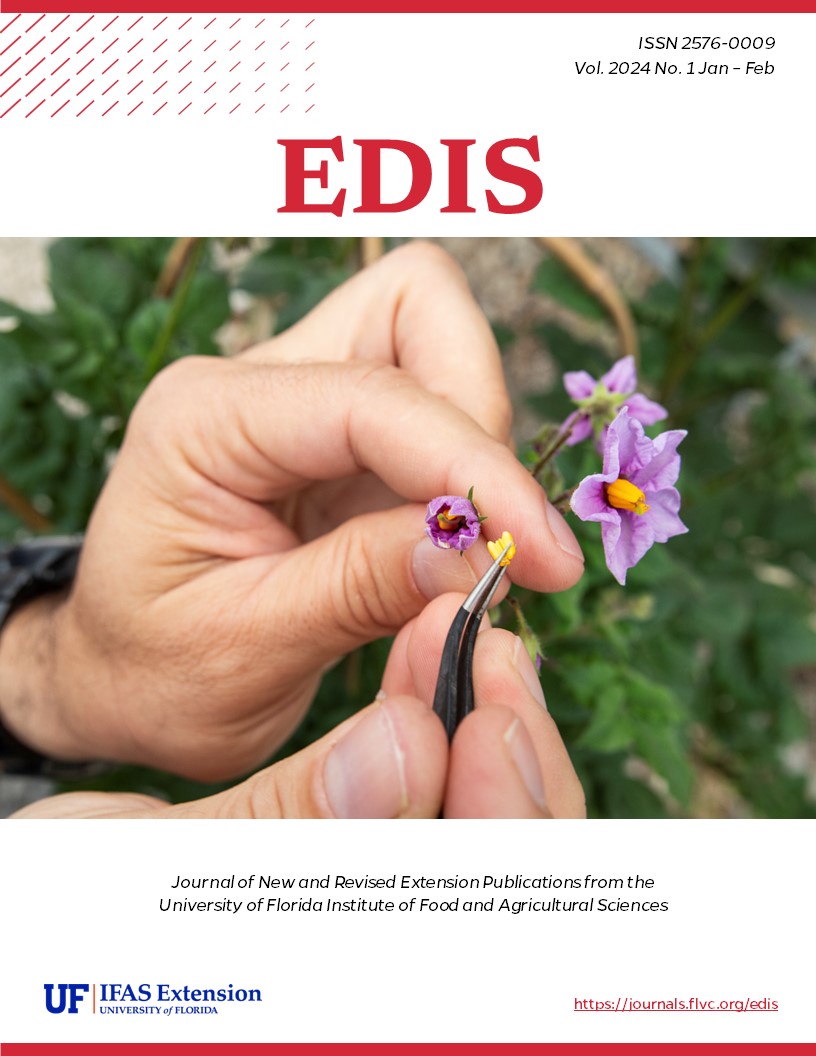Abstract
The genus Pityopsis, the silkgrasses, are perennial forbs that look like grass with silky, silver hairs. Recognizing different species of silkgrass is important for land managers who are striving to restore specific plant communities and for nurseries selling and distributing native plant materials throughout Florida. Academic botanical keys make identification of silkgrass species challenging for those without a botanical background. This publication provides a breakdown of botanical terms used to describe silkgrass species and a guide with pictures and descriptions of various species to aid in differentiating between them. In addition, the publication provides information about phenology, seed harvesting, and propagation for silkgrasses and presents many practical applications for these attractive and useful plants.
References
Brewer, S. J. 1995. “The Relationship between Soil Fertility and Fire-Stimulated Floral Induction in Two Populations of Grass-Leaved Golden Aster, Pityopsis graminifolia.” Oikos 74:45–54. https://doi.org/10.2307/3545673
Brewer, J. S., and W. J. Platt. 1994. “Effects of Fire Season and Herbivory on Reproductive Success in a Clonal Forb, Pityopsis Graminifolia.” Journal of Ecology 82:665–675. https://doi.org/10.2307/2261273
Brewer, J. S., and W. J. Platt. 1994. “Effects of Fire Season and Soil Fertility on Clonal Growth in a Pyrophilic Forb, Pityopsis graminifolia (Asteraceae).” American Journal of Botany 81:805–814. https://doi.org/10.1002/j.1537-2197.1994.tb15561.x
Brewer, J. S., W. J. Platt, J. S. Glitzenstein, and D. R. Streng. 1994. “Effects of Fire-Generated Gaps on Growth and Reproduction of Golden Aster (Pityopsis graminifolia).” Bulletin of the Torrey Botanical Club 123:295–303. https://doi.org/10.2307/2996778
Deyrup, M., J. Edirisinghe, and B. Norden. 2002. “The Diversity and Floral Hosts of Bees at the Archbold Biological Station, Florida (Hymenoptera: Apoidea).” Insecta mundi 16:87–119.
Gowe, A. K., and J. S. Brewer. 2005. The Evolution of Fire-Dependent Flowering in Goldenasters (Pityopsis spp.). The Journal of the Torrey Botanical Society 132:384–400. https://doi.org/10.3159/1095-5674(2005)132[384:TEOFFI]2.0.CO;2
Hatmaker, E. A., P. A. Wadl, T. A. Rinehart, J. Carroll, T. S. Lane, R. N. Trigiano, M. E. Staton, and E. E. Schilling. 2020. “Complete Chloroplast Genome Comparisons for Pityopsis (Asteraceae).” PLoS One 15, e0241391. https://doi.org/10.1371/journal.pone.0241391
Kujawski, J., J. Englert, D. Dusty, and J. Ugiansky. 2001. Equipment Modifications for Harvesting Fluffy Seeds Native Plants Journal 2:114-115 https://doi.org/10.3368/npj.2.2.114
Lindon, H. L., and E. Menges. 2008. “Effects of Smoke on Seed Germination of Twenty Species of Fire-Prone Habitats in Florida.” Castanea 73:106–110. https://doi.org/10.2179/0008-7475(2008)73[106:EOSOSG]2.0.CO;2
Nesom, G. L. (2019). Taxonomic synopsis of pityopsis (asteraceae). Phytoneuron, 2019 (1):1-31.
Simkin, S. M., W. K. Michener, and R. Wyatt. 2001. “Plant Response Following Soil Disturbance in a Longleaf Pine Ecosystem.” The Journal of the Torrey Botanical Society 128:208–218. https://doi.org/10.2307/3088712
Thetford, M., J. G. Norcini, B. Ballard, and J. H. Aldrich. 2009. “Ornamental Landscape Performance of Native and Nonnative Grasses under Low-Input Conditions.” HortTechnology 19 (2): 267–285. https://doi.org/10.21273/HORTTECH.19.2.267
USDA, NRCS. 2007. Plant Fact Sheet “Narrowleaf Silkgrass Pityopsis graminifolia (Michx.) Nutt.” Prepared by: Shawn Belt and Mary Ann Gonter. Contributed by: USDA NRCS National Plant Materials Center (NPMC), Beltsville, Maryland. Edited 2007. Recovered from The PLANTS Database (http://plants.usda.gov, 12/13/2023). National Plant Data Team, Greensboro, NC USA. https://plants.usda.gov/DocumentLibrary/factsheet/pdf/fs_pigr4.pdf.
Weakley, A. S., and M. T. Lee. 2020. “Flora of the Southeastern United States.” https://fsus.ncbg.unc.edu/
Wunderlin, R. P., B. F. Hansen, A. R. Franck, and F. B. Essig. 2023. Atlas of Florida Plants (http://florida.plantatlas.usf.edu/). [S. M. Landry and K. N. Campbell (application development), USF Water Institute.] Institute for Systematic Botany, University of South Florida, Tampa.
Zinn, T. 2014. 10 Easy Wildflowers: Your guide to Florida native wildflowers for landscapes. Florida Wildflower Foundation. https://www.flawildflowers.org/wp-content/resources/pdfs/Publications/10EasyWildflowers.pdf.

This work is licensed under a Creative Commons Attribution-NonCommercial-NoDerivatives 4.0 International License.
Copyright (c) 2024 UF/IFAS

